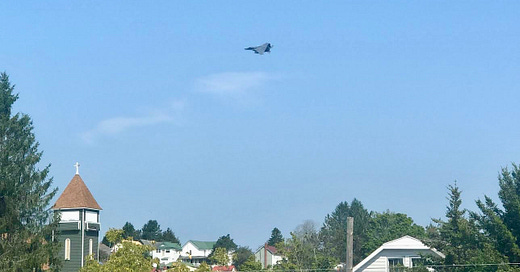Top Gun in Tucker County: Fighter Pilots Train to Hit Their Mark
Plus, a new brewpub and an arcade open in Davis, and more
By Mat Cloak, contributing writer
If you’ve spent much time in Tucker County, you’ve probably experienced a low-altitude fighter jet blasting overhead. These training flights are frequent enough to be part of the Tucker County experience.
Why here? The rough terrain, some obvious landmarks, and proximity to military bases are among the reasons this region is a favorite for training pilots.
There are three types of fighter jets that frequently run training flights on two military training routes above Davis and Canaan Valley.
The F-15 Strike Eagle is used by the Air Force. There are F-15s stationed at Seymour Johnson Air Force Base in North Carolina.
The F-18 Super Hornet is used by the Navy. There are F-18s stationed at Naval air bases Patuxent River in Maryland and Oceana in Virginia Beach.
The F-16 Fighting Falcon is used by both the Air Force and National Guard. There are F-16s stationed at Joint Base Andrews in Maryland.
Ideal terrain
The two military training routes that are directly over Tucker County are considered “visual routes” because the pilots are using their own navigational skills to navigate. These routes are often flown less than 1,500 feet above the terrain. One route lies over Canaan Valley at a southwesterly angle, and the other route runs east to west directly over Davis.
“That’s part of the training — getting good enough at reading the terrain and a map so you can find your target.”
Matt Taylor, local aviator and Marine veteran, flew the two routes over Davis and Canaan Valley during his time in the military. “Flying a jet is like a sport, you have to practice it a lot to become proficient,” he said. Taylor conducted flight tests on F-18s and F-35s stationed out of Naval Air Station Patuxent River.
Taylor said the mountains provide ideal terrain to navigate for live flight training.
The routes over Tucker County were commonly used for F-18 training runs from Patuxent River because of their proximity to the base, Taylor said. “You could fly the whole route and have enough fuel to get home comfortably,” he said. Taylor said it would take about 20 minutes to fly the 170 miles from Patuxent River to Davis.
The pilots fly at a high altitude until Moorefield, where they descend to begin the low-altitude training. It’s rare to see a single jet on a training flight. Taylor said flying in pairs makes for more realistic training.
“You don’t like excitement when you do stuff like that.”
Pilots have to navigate the terrain, read the weather, operate a sophisticated aircraft, and locate a practice target at a predetermined point in time. “If you’re going 400 mph, you have to not hit the ground, not hit your wingman, not hit any other airplanes that are out there,” Taylor said.
Taylor said a good practice target is a landmark that is identifiable but not too easy to pick out. “That’s part of the training — getting good enough at reading the terrain and a map so you can find your target. And you can do it going really fast and not having seen it before,” he said.
Some practice targets may be more obvious than others. The Mount Storm power plant may be one particularly prominent landmark used by pilots for navigation.
When asked about any exciting stories during his training flights, Taylor responded, “We tried to keep things boring. You don’t like excitement when you do stuff like that.”
“Unimaginably rough”
Davis resident Evan Supak recalls flyovers as early as he can remember. “Flyovers have been happening at least since the early 90's on a regular basis,” Supak said. “Back in those days, a lot of the jets I remember seeing were A-6 Intruder's and the occasional F-14.”
There are always risks associated with military activity. During World War II, the Dolly Sods Wilderness area was used for artillery training, and visitors are warned that unexploded shells might still be found in the area.
In 1991, an A-6 Intruder flying out of Naval Air Station Oceana crashed near the Stony River Reservoir in Grant County. According to an Associated Press article about the accident, then-Tucker County Sheriff Hank Thompson “called the terrain ‘unimaginably rough.’” He added, “you can come up here any day of the week at Thomas and Davis and see them flying down the canyon.’” Both men in the aircraft died in the crash.
Breaking windows
While these low-altitude flights often appear to be operating at extremely high speeds, the fighter jets usually don’t exceed the speed of sound. The military has rules that generally prohibit fighter jets from breaking the sound barrier during training runs over populated areas because sonic booms can alarm people on the ground.
“These jets never get near the sound barrier when on these routes,” Taylor said. “At low altitude, the speed of sound is well over 700 mph. These jets are flying generally between 300 and 400. Supersonic flight is only allowed in very specific, restricted airspace, or over the ocean at high altitudes, due to likely property damage from sonic booms.”
Taylor added that if the jets flying at low altitude over Tucker County broke the sound barrier, which they could easily do, “they'd frequently break windows with the sonic boom. It would be very dramatic, and bad!”
Taylor noted that people on the ground wouldn’t be able to hear jets approaching at supersonic speed until after they pass by. “We’d hear nothing until a sonic boom, broken windows, and then the jet noise we often hear,” he said.
In addition to the fighter jets, other military aircraft occasionally are spotted flying over the area. The V-22 Osprey, a vertical take-off cargo aircraft; the C-17 Globemaster and C-130 Hercules, both large transport aircraft; and Black Hawk helicopters have been seen in the skies above Tucker County.
Taylor speculated that newer, more advanced jets like the F-35 might soon be seen flying over Tucker County as well.
News in Brief
The Arcade in Davis is Open!
Country Roads News in February profiled a local dentist’s plans to open a pinball and video arcade in Davis to give kids a place to hang out together in their free time.
That day has arrived.
The Toothache Arcade opened today. The initial plan is for the arcade to be open from 11 a.m. to 9 p.m. Saturdays; 1 to 5 p.m. Sundays; 5 to 8 p.m Wednesdays and Thursdays; and 5 to 9 p.m. Fridays. The arcade will be closed Mondays and Tuesdays. The arcade may be open longer hours during the summer.
New Bus Service Seeks Rider Feedback
We published a story May 12 about a new transit service coming to Tucker County this summer. Many readers expressed enthusiasm for the new transportation option.
The details are still in the works, and the company operating the bus line is seeking suggestions for routes and schedules. Click here to share your thoughts.
Big Timber Brewing’s Davis Location Opens
Elkins-based Big Timber Brewing, which originally planned to open its new Davis location on Thursday, missed that mark by a day and opened Friday.
The hours for now are 4 to 10 p.m. Friday, noon to 10 p.m. Saturday, and noon to 8 p.m. Sunday and Monday.
Editor’s Note: Online vs. Print
People occasionally ask if I plan to introduce a print version of this publication. I love ink and paper. I got my start in this business years before most newspapers had a website.
But the answer is no.
The events of the past two months have solidified that decision. The sudden emergence of a proposed power plant and data centers in our midst required a rapid response. I frequently found myself racing to publish an edition ahead of key legislative action and other fast-moving developments. Sometimes I had a few hours, not days or weeks, to make that happen.
Anyone with a smartphone can read this publication the second we publish new stories, and I want citizens to know what their elected officials plan to do before they do it.
While Country Roads News occasionally publishes feature stories, like Mat Cloak’s nifty report in today’s edition about military training flights, hard news is the core of our work, and I let the news decide the publication schedule. I aim to publish approximately once a week, but I recently published three editions in five days. On rare occasions, we’ve gone nearly two weeks between editions.
I won’t make you wait for important news when events are popping, and I won’t bore you with filler when things are slow.
I still enjoy reading print publications, and I admire those who do it well. Print publishing makes a lot of sense for certain publications like Highland Outdoors, with its outstanding photography, timeless stories, and longer production schedule.
Country Roads News aims to serve our community in a different way. The best way to execute our mission with our tiny staff is by remaining nimble — untethered from artificial deadlines and unburdened by the time-consuming process of laying out a print product.
I’m an old guy, but I’ve learned some new tricks. Thank you for joining me on this wild ride.
Dan
P.S. Tune in to NPR Sunday morning, when I’m tentatively scheduled to make a brief appearance on Weekend Edition to discuss the local data center controversy.








Your interview on NPR was great.
Really enjoyable to be kept informed on these topics.